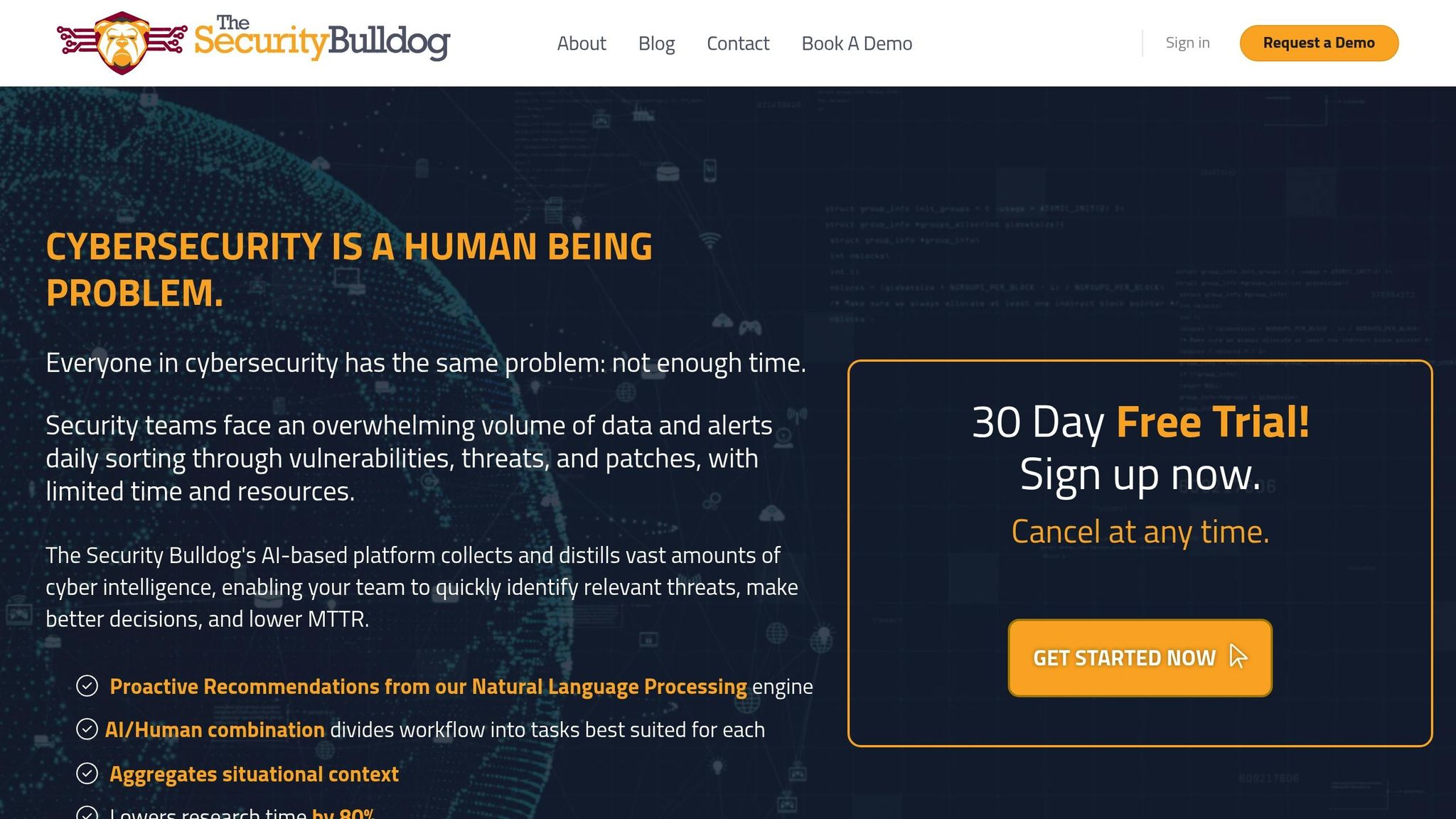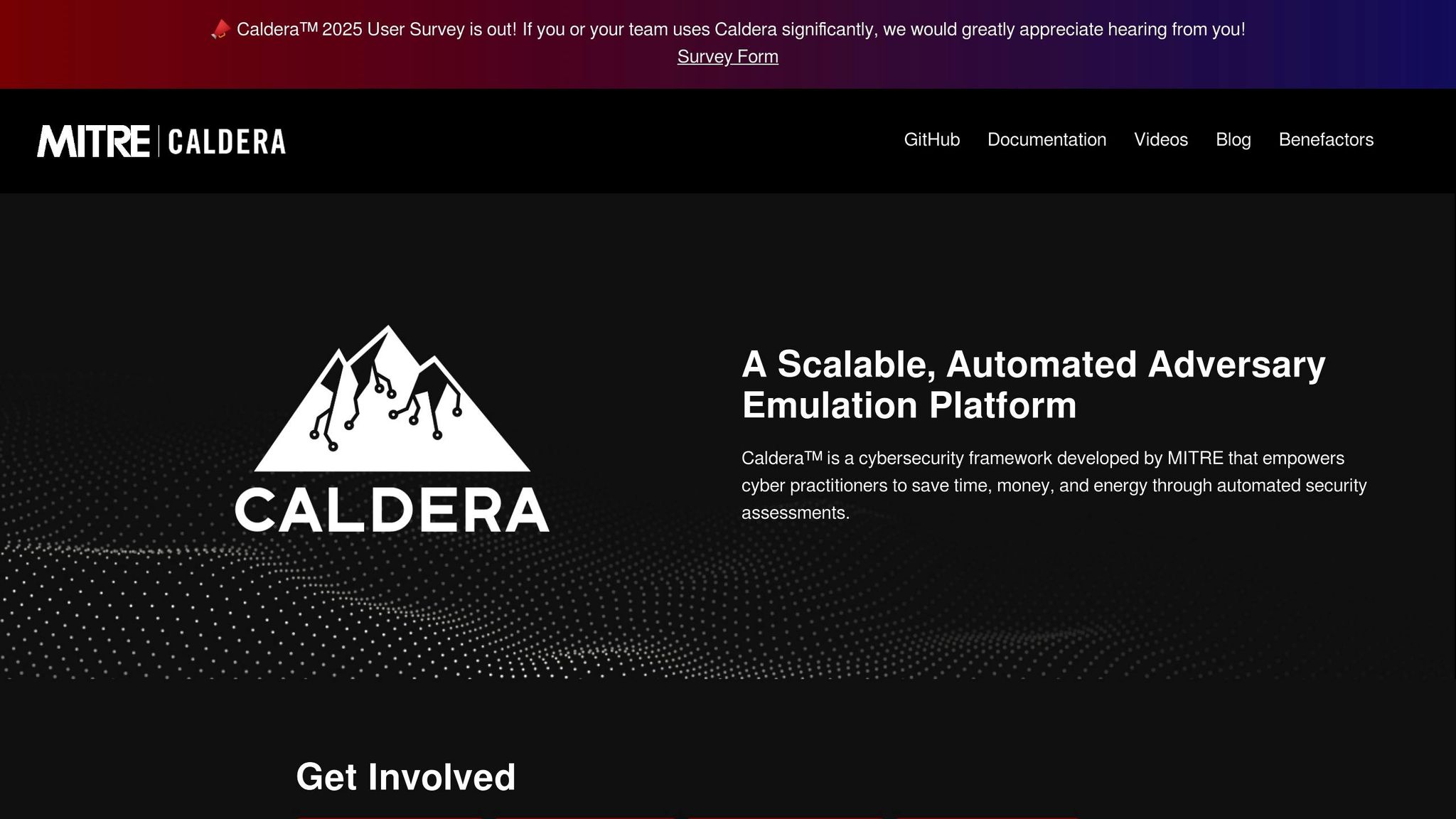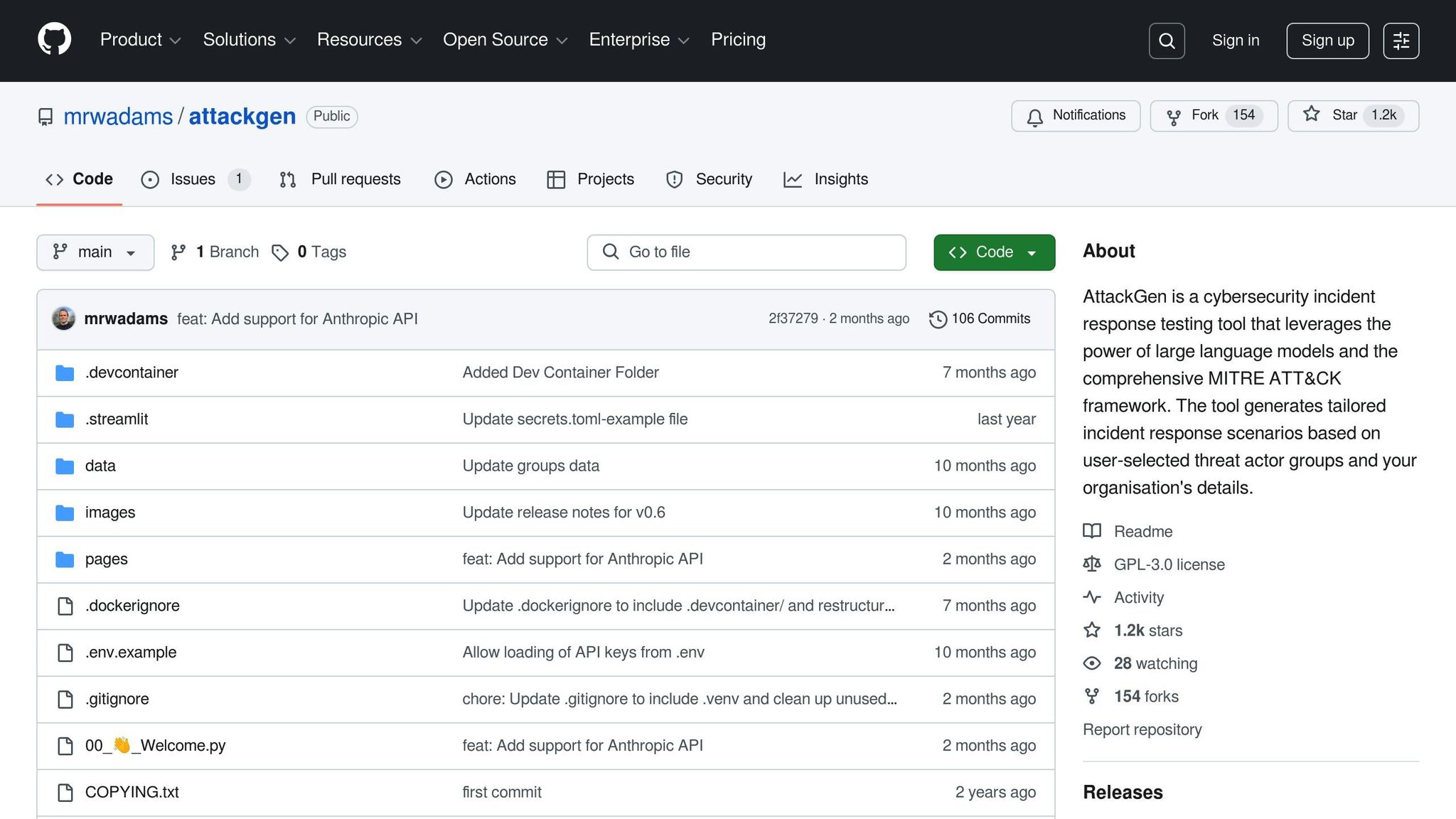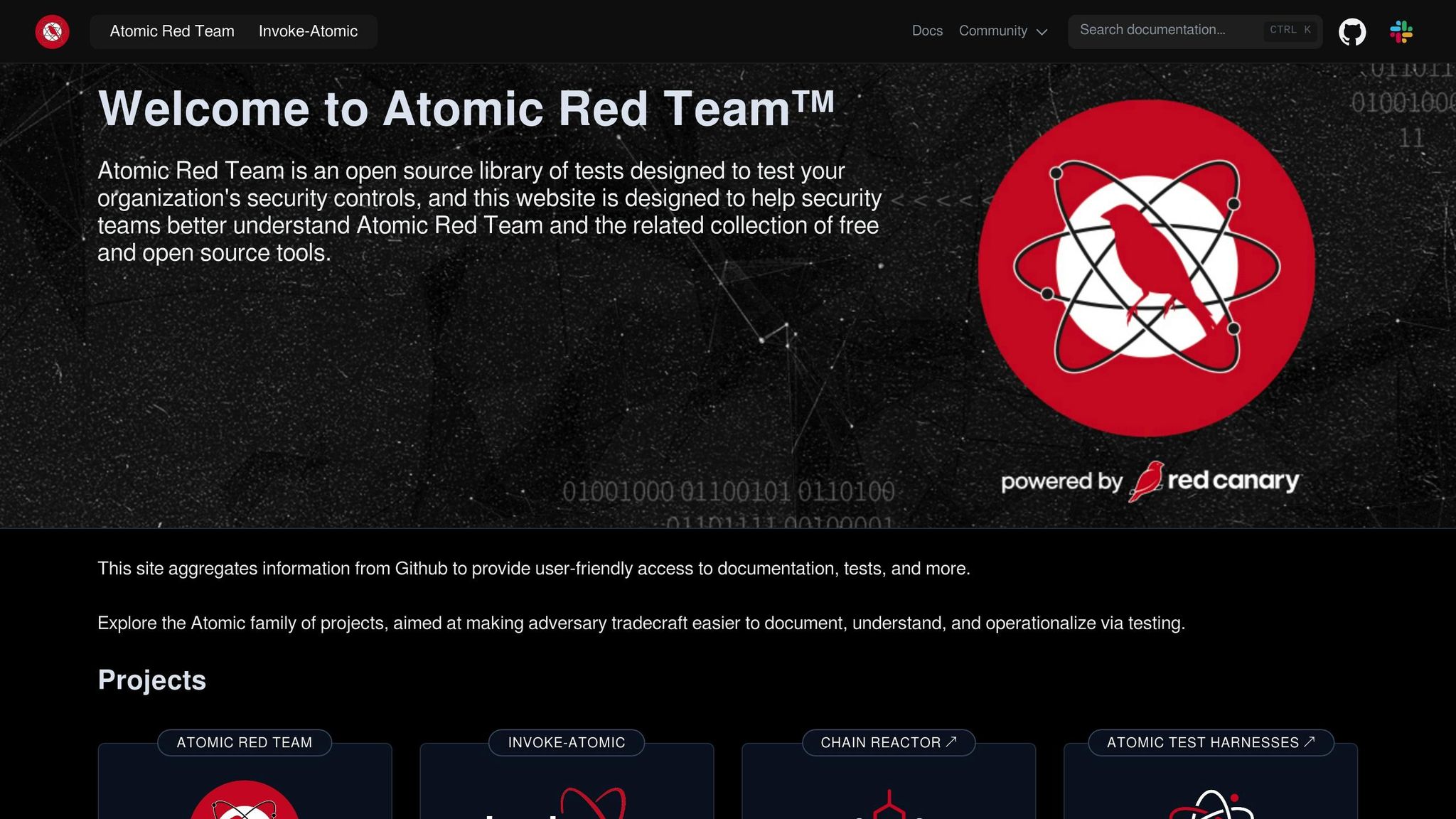Top Tools for MITRE ATT&CK-Based Incident Response
MITRE ATT&CK tools are transforming how organizations tackle cyber threats. These tools simplify threat analysis, automate incident response, and enhance detection capabilities. Here’s a quick breakdown of five powerful options tailored to different needs:
- The Security Bulldog: AI-driven platform for automating MITRE ATT&CK mapping, reducing research time, and integrating with existing security tools. Starts at $850/month.
- MITRE ATT&CK Navigator: Free, web-based tool for visualizing attack techniques and identifying coverage gaps. Ideal for SOC teams.
- MITRE Caldera: Open-source platform for simulating adversary behavior and testing defenses. Perfect for red teams.
- AttackGen: Uses large language models to generate custom incident scenarios based on MITRE ATT&CK techniques. Free and highly customizable.
- Atomic Red Team: Open-source library of 1,225 tests mapped to 261 ATT&CK techniques. Great for validating detection rules and improving defenses.
Quick Comparison:
| Tool | Cost | Focus Area | Key Feature |
|---|---|---|---|
| The Security Bulldog | $850/month | Threat intelligence | AI-driven automation and integration |
| ATT&CK Navigator | Free | Visualization and analysis | Interactive ATT&CK matrix visualization |
| MITRE Caldera | Free | Adversary simulation | Automated red team operations |
| AttackGen | Free | Scenario generation | Custom scenarios using large language models |
| Atomic Red Team | Free | Detection testing | Extensive library of ATT&CK-aligned tests |
These tools cater to various needs, from small teams seeking free resources to enterprises investing in AI-powered solutions. Whether you’re mapping threats, simulating attacks, or refining detection rules, there’s a tool to support your efforts.
Workshop: MITRE ATT&CK and the ATT&CK Navigator (Part 2 of 2) | Carrie Roberts | WWHF 2023
1. The Security Bulldog

The Security Bulldog is an AI-driven cybersecurity platform designed to simplify MITRE ATT&CK-based incident response. Powered by a proprietary Natural Language Processing (NLP) engine, it condenses open-source cyber intelligence, helping security teams cut down research time, grasp threats more quickly, and speed up detection and response efforts. Essentially, it transforms the often tedious process of mapping threat data into a streamlined, automated workflow.
Mapping to MITRE ATT&CK Techniques
This platform integrates the MITRE ATT&CK framework directly into its intelligence-gathering process. By automating the organization of ATT&CK-related data from various sources, it reduces the need for manual work. Its NLP engine processes a wide array of threat intelligence, including ATT&CK data, CVEs, podcasts, and news, delivering timely and context-rich insights to users.
Integration with Existing Security Tools
One of The Security Bulldog’s standout features is its ability to blend seamlessly with existing security infrastructures. It allows for easy sharing and collaboration while accommodating custom integrations to fit unique organizational needs. Soon, an API will enable automated data feeds into tools like SIEM systems, SOAR platforms, and other security solutions.
In addition to its integration capabilities, the platform automates repetitive tasks, boosting efficiency across the board.
Automation and Scalability
By automating many incident response tasks, The Security Bulldog frees up analysts to focus on more strategic activities like threat hunting and system improvements. This kind of automation can make a big difference – organizations that embrace security AI and automation see a 65.2% reduction in total breach costs. This is especially crucial considering that 69% of security professionals report experiencing burnout symptoms, with many even contemplating leaving their roles due to stress.
Support for Threat Detection and Incident Response
The platform takes a comprehensive approach, supporting both proactive threat detection and reactive incident response. It provides tailored intelligence feeds for specific IT environments, offering actionable insights that enhance detection rules and guide incident response plans. Additionally, its vulnerability management tools help teams connect emerging threats to their existing security setups, ensuring they prioritize responses based on the severity and potential impact of threats.
With pricing starting at $850 per month or $9,350 annually for up to 10 users, The Security Bulldog offers a scalable solution that includes 24/7 support, custom feeds, and strong integration capabilities. For larger enterprises, the Enterprise Pro plan adds advanced features like custom SOAR/SIEM integrations, metered data access, and dedicated training support.
2. MITRE ATT&CK Navigator
The MITRE ATT&CK Navigator is a web-based tool designed to simplify how security teams analyze and track adversary tactics and techniques. Unlike traditional spreadsheets, this interactive platform provides a user-friendly way to access the complexities of the MITRE ATT&CK framework, making it an essential resource for SOC analysts, threat hunters, and incident responders.
Mapping to MITRE ATT&CK Techniques
One of Navigator’s standout features is its ability to help security teams map observed attack techniques to specific entries in the MITRE ATT&CK framework. By overlaying attack patterns onto a visual grid, analysts can gain a clear picture of the tactics and techniques adversaries are using.
For instance, during a ransomware investigation, SOC teams can map each attacker action to its corresponding ATT&CK technique. A phishing email might align with T1566.001 (Spearphishing Attachment), PowerShell execution with T1059.001 (Command and Scripting Interpreter), privilege escalation with T1134.001 (Token Impersonation), and ransomware deployment with T1486 (Data Encrypted for Impact). This structured approach not only speeds up detection and containment but also enhances threat intelligence by clearly identifying affected systems and the methods used by attackers.
Integration with Existing Security Tools
The Navigator integrates seamlessly with tools like EDR systems, SIEM platforms, and forensic logs, allowing teams to visualize indicators of compromise from multiple sources in a single interface. This eliminates the need to juggle several analysis tools.
The platform’s layer functionality, similar to what you’d find in graphic design software, lets users overlay different datasets for comparison without altering the original information. This feature is particularly useful for incorporating threat intelligence feeds or tracking recent adversary activity. By doing so, teams can ensure their defenses stay aligned with evolving threats.
Support for Threat Detection and Incident Response
Navigator is a powerful asset for both detecting threats proactively and responding to incidents effectively. It highlights gaps in defensive coverage by showing which techniques are detected and which are not, helping teams focus their efforts on areas that need the most attention.
During an incident, Navigator provides a clear map of attacker techniques, enabling teams to act strategically. For example, they can prioritize containment by blocking malicious scripts and isolating compromised devices, then move on to eradication by removing persistence mechanisms like registry changes or scheduled tasks.
In post-incident reviews, Navigator documents both detected and missed techniques, offering valuable insights for refining SIEM alerts and detection rules. This data helps teams better protect vulnerable areas. Additionally, by creating separate layers for different threat actors, teams can spot recurring tactics and focus their defenses on the most common attack methods.
The visualization capabilities of Navigator also serve as a strong foundation for simulation tools, helping teams fine-tune their incident response strategies even further.
3. MITRE Caldera

MITRE Caldera is an automated platform designed to emulate adversary behavior, built directly on the MITRE ATT&CK framework. It transforms the framework into actionable operations by running realistic attack simulations. These simulations help security teams visualize how attackers might move through their networks, converting static threat intelligence into hands-on testing. Unlike tools that merely aggregate or display threat data, Caldera actively tests defenses by simulating attacks, making it a powerful tool for evaluating incident response protocols.
Mapping to MITRE ATT&CK Techniques
One of Caldera’s standout features is its deep integration with the MITRE ATT&CK framework. By chaining together ATT&CK techniques, it simulates the behaviors of real-world threat actors. This approach focuses on tactics, techniques, and procedures (TTPs), which represent the most challenging elements for attackers to change, as outlined in the Pyramid of Pain. By targeting these behaviors instead of specific tools, organizations can disrupt attacks more effectively. Every action performed during a Caldera operation is mapped to a corresponding ATT&CK technique, providing a clear view of how an attack might progress through the kill chain.
For example, in a 2022 demonstration, Caldera successfully bypassed Windows Security on a Windows 10 system, showcasing its ability to replicate advanced attack techniques.
Automation and Scalability
Caldera addresses a common issue in cybersecurity testing: limited resources. It automates red team assessments without compromising on complexity, making it an essential addition to any security toolkit. Its dynamic learning capability allows it to adjust commands in real time based on the execution environment, creating highly realistic testing scenarios.
One of its key strengths is the ability to run repeatable tests, regardless of the operator’s skill level. This makes advanced security testing accessible to a broader range of teams, freeing up experts to tackle more complex challenges. Additionally, Caldera’s modular plugin system supports custom operations and automates entire attack chains, helping organizations identify and address detection and response gaps systematically.
Integration with Existing Security Tools
Caldera’s flexible architecture makes it easy to integrate into existing security ecosystems. It features an asynchronous command-and-control server, along with a REST API and web interface, enabling seamless connections with tools like SIEM platforms, EDR systems, and more. This integration ensures that Caldera’s results can be directly fed into workflows, triggering alerts and providing actionable data for threat hunting and analysis.
Support for Threat Detection and Incident Response
Caldera serves multiple roles in enhancing an organization’s security posture. By simulating adversary penetration, it helps identify network vulnerabilities and evaluates defenses from an attacker’s perspective. For incident response teams, it offers valuable training opportunities, allowing them to refine their response strategies against realistic attack scenarios. It also tests multiple layers of defense simultaneously, revealing detection gaps and improving response times.
Moreover, Caldera’s ATT&CK-based simulations can guide the development of incident playbooks. By aligning simulated activity with common TTPs, it supports efforts to detect threats, analyze technical details, and correlate events for more accurate timelines. These outputs can be used alongside tools like The Security Bulldog and Navigator to enhance incident response strategies, ensuring a cohesive approach to threat detection and mitigation.
4. AttackGen

AttackGen is a cybersecurity tool that combines large language models with the MITRE ATT&CK framework to enhance incident response. By using this approach, security teams can create incident response scenarios tailored to their organization’s specific needs and threat environment. Unlike static testing tools, AttackGen generates dynamic scenarios that mirror real-world attack patterns and organizational contexts, aligning with industry standards for efficient incident response. This integration enables a high level of automation and customization.
Mapping to MITRE ATT&CK Techniques
AttackGen utilizes the MITRE ATT&CK v15.1 framework, which includes over 300 techniques, to craft scenarios that are both specific and actionable. Users can select particular ATT&CK techniques to design custom scenarios, giving them precise control over the testing process. This functionality spans both the Enterprise and ICS (Industrial Control Systems) matrices, making it versatile enough for industries ranging from corporate enterprises to critical infrastructure.
The tool also displays detailed techniques linked to specific threat actor groups from the MITRE ATT&CK database. This helps security teams better understand adversary tactics and pinpoint vulnerabilities in their defenses.
Automation and Scalability
AttackGen takes its mapping capabilities further by automating scenario creation with the help of large language models. It generates incident response scenarios tailored to threat actor profiles, industry characteristics, and company size, removing the need for manual effort in crafting realistic scenarios.
The platform integrates with a range of large language models, including OpenAI, Google AI, Mistral, Groq APIs, Azure OpenAI Service, and locally hosted Ollama models. Its Docker-based deployment model ensures easy setup across various environments. Additionally, integration with LangSmith supports debugging, testing, and model monitoring, maintaining quality as the platform scales.
Support for Threat Detection and Incident Response
AttackGen enhances incident response readiness by providing real-time monitoring and automated recommendations that significantly reduce response times. Its ability to generate scenarios tailored to an organization’s unique context allows security teams to train against the most relevant threats.
The platform includes templates for common cyber incidents, enabling teams to begin testing right away. By automating threat detection and incident classification, AttackGen helps organizations refine detection rules and streamline response procedures. This functionality is increasingly critical as global cybercrime costs are projected to reach $10.5 trillion by 2025. By focusing on the most pressing threats, AttackGen ensures that teams can strengthen their defenses and maintain an effective, MITRE ATT&CK-aligned incident response strategy.
sbb-itb-9b7603c
5. Atomic Red Team

Atomic Red Team stands out as an open-source framework designed specifically for targeted threat detection testing, aligning with the MITRE ATT&CK framework. It offers a library of 1,225 atomic tests mapped to 261 ATT&CK techniques, giving security teams the tools to evaluate and improve their detection capabilities. Each test focuses on a single technique, making it easier to assess security defenses in a controlled and repeatable way.
Mapping to MITRE ATT&CK Techniques
Every test in Atomic Red Team corresponds to a specific ATT&CK technique ID, ensuring clear alignment with the framework. This precise mapping allows teams to systematically track their detection coverage and identify gaps. For example, a team looking to validate its detection rule for T1135 – Network Share Discovery might use the following command:
Invoke-AtomicTest T1135 -TestNumbers 2 If the test fails to trigger a detection, the team can refine its detection rules or enable additional logging to address the gap. Pairing Atomic Red Team with tools like the ATT&CK Navigator further helps visualize test outcomes and locate areas that need improvement.
Integration with Existing Security Tools
Atomic Red Team integrates smoothly with a variety of security tools, enhancing workflows for threat detection and response. For instance:
- SIEM Solutions: Tools like Wazuh can use Atomic Red Team to simulate and detect specific attack patterns, such as T1003-6.
- Azure Sentinel: By forwarding logs from virtual machines to a Log Analytics workspace, security teams can conduct thorough threat detection tests.
- Containerized Environments: Platforms like Datadog‘s Workload Security Evaluator simplify running Atomic Red Team tests within container setups.
These integrations enable security teams to conduct comprehensive testing and improve their defenses, making Atomic Red Team a valuable addition to enterprise environments.
Automation and Scalability
While Atomic Red Team is highly effective, its default configuration lacks built-in automation, which can make manual testing impractical for larger environments. However, automation can be achieved by integrating it with tools like Velociraptor. This digital forensics and incident response tool allows remote command execution, automated result collection, and seamless integration with SIEM/SOAR platforms. For example, SOCFortress CoPilot can trigger Velociraptor artifacts and display results automatically. Similarly, teams using Microsoft Defender for Endpoint can run atomic tests directly from the platform’s interface, simplifying the process. Execution frameworks like Invoke-Atomic also enhance testing in more complex setups.
Support for Threat Detection and Incident Response
Atomic Red Team is not just about testing – it plays a crucial role in refining incident response strategies. By simulating specific threat behaviors, teams can validate detection rules, reduce false positives, and improve monitoring. These simulations can be integrated into training exercises or tabletop scenarios. Additionally, the insights gained help craft more precise Sysmon configurations, filtering out benign activity and reducing log noise. This improves the signal-to-noise ratio, making it easier for analysts to focus on genuine threats.
When combined with tools like The Security Bulldog and ATT&CK Navigator, Atomic Red Team becomes part of a cohesive, ATT&CK-aligned incident response workflow, helping security teams stay prepared for evolving threats.
Tool Comparison Table
Choose the MITRE ATT&CK tool that aligns with your needs, budget, and technical goals. Below is a breakdown of each tool’s features, capabilities, and pricing to help you make an informed decision.
| Tool | ATT&CK Mapping | Integration Capabilities | Automation Features | Pricing (USD) | Best For |
|---|---|---|---|---|---|
| The Security Bulldog | Full MITRE ATT&CK database with AI-driven analysis | SOAR/SIEM integrations, API access, custom feeds | AI-powered threat intelligence automation, semantic analysis | $850/month or $9,350/year (Enterprise) | Teams seeking AI-enhanced threat intelligence and faster research |
| MITRE ATT&CK Navigator | Native ATT&CK visualization and navigation | Web-based platform, JSON export/import | Limited automation, primarily manual visualization | Free | Security teams focusing on ATT&CK matrix visualization and gap analysis |
| MITRE Caldera | Built-in ATT&CK technique mapping for red team operations | Plugin architecture, REST API, agent-based deployment | Fully automated adversary emulation and red team exercises | Free (open source) | Red teams and organizations needing automated adversary simulation |
| AttackGen | Direct mapping to ATT&CK techniques for test generation | Command-line interface, scriptable execution | Automated test case generation based on ATT&CK techniques | Free (open source) | Teams aiming for automated security control testing |
| Atomic Red Team | 1,225 atomic tests mapped to 261 ATT&CK techniques | PowerShell, Bash, SIEM integration (Wazuh, Azure Sentinel) | Manual by default; automation possible with Velociraptor integration | Free (open source) | Organizations focused on detection rule validation and purple team exercises |
This table highlights the key capabilities of each tool. Here’s how to decide which one fits your needs:
Key Considerations for Tool Selection
- For budget-conscious teams, free tools like MITRE ATT&CK Navigator, Caldera, and Atomic Red Team are excellent options. They offer robust ATT&CK mapping without licensing fees, though they may demand more technical expertise for setup and maintenance.
- Enterprise security teams may find The Security Bulldog particularly useful. With its AI-powered threat intelligence and automation, it can significantly reduce analyst workload. At $850 per month, it’s a time-saving investment for teams managing large-scale operations.
- Red teams will benefit most from MITRE Caldera. Its automated adversary emulation and plugin architecture allow for extensive customization, making it a powerful and free solution for organizations of any size.
- Detection engineering teams should consider Atomic Red Team. Its extensive library of tests mapped to ATT&CK techniques provides a systematic way to validate detection rules. While automation is possible, additional integrations like Velociraptor are required.
- A hybrid approach can be ideal for many organizations. Combining tools for visualization, detection, and threat intelligence can provide a well-rounded strategy that leverages the strengths of each tool while managing costs efficiently.
When selecting tools, remember to account for total ownership costs, including setup and management time, versus the benefits of automation. A thoughtful combination of these tools can help create a unified, MITRE ATT&CK-aligned response strategy tailored to your organization’s needs.
Conclusion
The world of cybersecurity is constantly shifting, and MITRE ATT&CK has become a cornerstone for helping security teams tackle increasingly sophisticated threats. With its detailed and expansive knowledge base, this framework lays a solid groundwork for building effective and responsive incident management strategies.
By shaping threat assessments and guiding the deployment of advanced tools, MITRE ATT&CK empowers organizations to adopt solutions that fit their unique requirements – whether that’s budget, technical expertise, or operational goals. The tools discussed here highlight how ATT&CK-based incident response can provide capabilities once reserved for the largest enterprises, making them accessible to a broader range of organizations.
Take The Security Bulldog, for example. It uses AI-driven automation to simplify threat research, significantly cutting response times. This addresses a key challenge many security teams face: an overwhelming amount of threat data with limited resources to analyze it. By aligning its processes with MITRE ATT&CK, it enhances the incident response strategies outlined earlier.
"Actionable threat intelligence in incident response is like having a well-trained security dog – always alert, ready to sniff out danger, and equipped to respond swiftly." – Reza Rafati, Founder, Threat Intelligence Lab
Integrating MITRE ATT&CK tools into existing security frameworks represents a major step toward a threat-informed defense. The benefits are clear: faster response times, better prioritization of threats, and improved collaboration across teams. One multinational tech company, for instance, saw a dramatic reduction in response times by incorporating MITRE ATT&CK into their operations. By correlating real-time alerts with ATT&CK techniques, they quickly pinpointed the root causes of breaches, turning static threat data into dynamic, real-time defenses.
Achieving success with these tools requires dedication. Regular updates to detection rules and threat models are essential, as the cyber threat landscape is always changing. Whether you opt for a single, all-encompassing solution or a combination of tools tailored to your needs, investing in MITRE ATT&CK-based strategies will strengthen your security posture and boost operational efficiency.
Organizations that embrace these tools will be better equipped to detect, respond to, and prevent the cyber threats that lie ahead.
FAQs
How do MITRE ATT&CK tools improve incident response for organizations of all sizes?
How MITRE ATT&CK Tools Enhance Incident Response
MITRE ATT&CK tools provide a comprehensive knowledge base of real-world adversary tactics and techniques, making them invaluable for improving incident response. These tools help security teams better identify, understand, and address threats. By using the framework, organizations can predict potential attack methods, address vulnerabilities in their defenses, and streamline how they respond to incidents.
For larger organizations, the framework is particularly useful in managing complex environments and ensuring coordination across multiple teams. On the other hand, smaller organizations can leverage its accessible insights to boost their detection and response efforts. By customizing strategies based on an organization’s size and unique threat landscape, MITRE ATT&CK supports a more efficient and proactive approach to cybersecurity.
What are the advantages of integrating MITRE ATT&CK with security tools like SIEM and SOAR platforms?
Integrating MITRE ATT&CK with security tools like SIEM and SOAR platforms can greatly enhance how organizations detect, analyze, and respond to threats. By mapping detections to attacker tactics and techniques, security teams gain clearer insights into potential risks and can act with greater precision.
This connection also simplifies workflows by automating repetitive tasks and leveraging playbooks built around known adversary behaviors. The outcome? Faster incident response, less manual work, and a stronger, more efficient security framework.
What’s the best way for organizations to choose a MITRE ATT&CK tool that fits their cybersecurity needs and budget?
Choosing the Right MITRE ATT&CK Tool
Selecting the best MITRE ATT&CK tool starts with a clear understanding of your organization’s specific threat landscape and operational priorities. By identifying which tactics and techniques from the MITRE ATT&CK framework are most applicable to your environment, you can narrow down tools that effectively target those areas.
Key considerations include how well the tool integrates with your current systems, its ability to scale as your needs grow, and the overall implementation costs. Tools that incorporate automation – like those designed to mimic adversary behaviors – can be a smart investment, offering both efficiency and enhanced detection and response capabilities. The goal is to match the tool’s features with your security objectives and budget, ensuring it addresses your organization’s unique requirements.